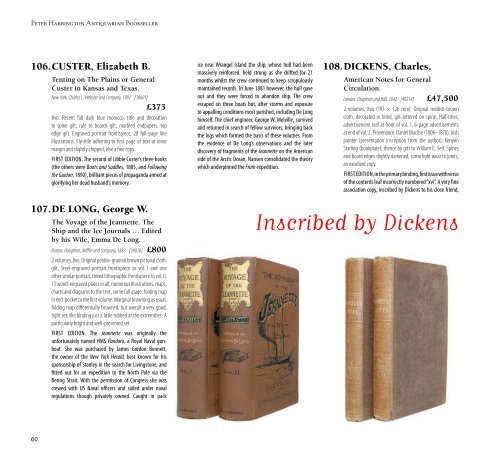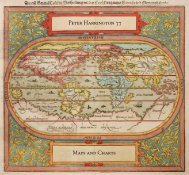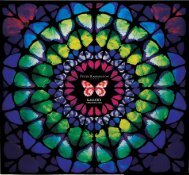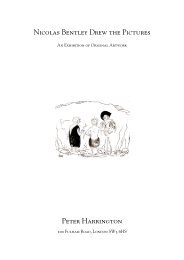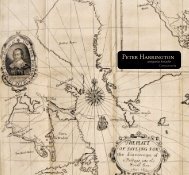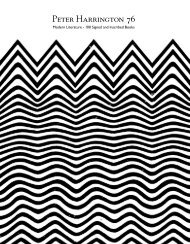antiquarian bookseller - Peter Harrington
antiquarian bookseller - Peter Harrington
antiquarian bookseller - Peter Harrington
Create successful ePaper yourself
Turn your PDF publications into a flip-book with our unique Google optimized e-Paper software.
<strong>Peter</strong> <strong>Harrington</strong> Antiquarian Bookseller<br />
106.CUSTER, Elizabeth B.<br />
Tenting on The Plains or General<br />
Custer in Kansas and Texas.<br />
New York, Charles L. Webster and Company, 1887 [30601]<br />
£375<br />
8vo. Recent full dark blue morocco, title and decoration<br />
to spine gilt, rule to boards gilt, marbled endpapers, top<br />
edge gilt. Engraved portrait frontispiece, 28 full-page line<br />
illustrations. Fly-title adhering to first page of text at inner<br />
margin and slightly chipped, else a fine copy.<br />
FIRST EDITION. The second of Libbie Custer’s three books<br />
(the others were Boots and Saddles, 1885, and Following<br />
the Guidon, 1890), brilliant pieces of propaganda aimed at<br />
glorifying her dead husband’s memory.<br />
107.DE LONG, George W.<br />
The Voyage of the Jeannette. The<br />
Ship and the Ice Journals … Edited<br />
by his Wife, Emma De Long.<br />
Boston, Houghton, Mifflin and Company, 1883 [39030] £800<br />
2 volumes, 8vo. Original pebble-grained brown pictorial cloth,<br />
gilt. Steel-engraved portrait frontispiece to vol. I and one<br />
other similar portrait, tinted lithographic frontispiece to vol. II,<br />
13 wood-engraved plates in all, numerous illustrations, maps,<br />
charts and diagrams to the text, some full-page, folding map<br />
in end-pocket to the first volume. Marginal browning as usual,<br />
folding map differentially browned, but overall a very good,<br />
tight set, the binding just a little rubbed at the extremities. A<br />
particularly bright and well-preserved set.<br />
FIRST EDITION. The Jeannette was originally the<br />
unfortunately named HMS Pandora, a Royal Naval gunboat.<br />
She was purchased by James Gordon Bennett,<br />
the owner of the New York Herald, best known for his<br />
sponsorship of Stanley in the search for Livingstone, and<br />
fitted out for an expedition to the North Pole via the<br />
Bering Strait. With the permission of Congress she was<br />
crewed with US Naval officers and sailed under naval<br />
regulations though privately owned. Caught in pack<br />
ice near Wrangel Island the ship, whose hull had been<br />
massively reinforced, held strong as she drifted for 21<br />
months whilst the crew continued to keep scrupulously<br />
maintained records. In June 1881 however, the hull gave<br />
out and they were forced to abandon ship. The crew<br />
escaped on three boats but, after storms and exposure<br />
to appalling conditions most perished, including De Long<br />
himself. The chief engineer, George W. Melville, survived<br />
and returned in search of fellow survivors, bringing back<br />
the logs which formed the basis of these volumes. From<br />
the evidence of De Long’s observations and the later<br />
discovery of fragments of the Jeannette on the American<br />
side of the Arctic Ocean, Nansen consolidated the theory<br />
which underpinned the Fram expedition.<br />
108.DICKENS, Charles.<br />
American Notes for General<br />
Circulation.<br />
London: Chapman and Hall, 1842 [40214] £47,500<br />
2 volumes, 8vo (197 × 126 mm). Original reddish-brown<br />
cloth, decorated in blind, gilt-lettered on spine. Half-titles,<br />
advertisement leaf at front of vol. 1, 6-page advertisements<br />
at end of vol. 2. Provenance: Daniel Maclise (1806–1870), Irish<br />
painter (presentation inscription from the author); Kenyon<br />
Starling (bookplate); thence by gift to William E. Self. Spines<br />
and board edges slightly darkened, some light wear to joints,<br />
an excellent copy.<br />
FIRST EDITION, in the primary binding, first issue with verso<br />
of the contents leaf incorrectly numbered “xvi”. A very fine<br />
association copy, inscribed by Dickens to his close friend,<br />
Inscribed by Dickens<br />
the painter Daniel Maclise on the half-title in volume one:<br />
“Daniel Maclise From his friend Charles Dickens Eighteenth<br />
October 1842,” one day prior to its official publication.<br />
Maclise was one of the first of his closest friends that<br />
Dickens went to visit after returning from his tiring trip<br />
to America in 1842. After an excited greeting from his<br />
children, Dickens dashed off to see William Macready,<br />
then quickly to John Forster. Forster was dining out, but<br />
he “guessed at once what [his interruption] was when<br />
Dickens drove there and sent up word that a gentleman<br />
wished to speak to him. Forster came flying out of the<br />
house, leaped into the carriage, and began to cry, and<br />
did not remember until they had driven several miles on<br />
their way to see Maclise that he had left his hat behind<br />
him” (Johnson, Charles Dickens, 1952, p.428). A reunion<br />
dinner the following week included Maclise as one of the<br />
featured guests, along with Forster, Macready, Cruikshank<br />
and Cattermole. Both slightly before and after this period,<br />
Maclise was completing his portraits of Dickens’s children.<br />
After the reunions subsided, Dickens began work on<br />
American Notes and borrowed back from his closest<br />
correspondents, including Maclise, letters that he had<br />
written during this journey, using them in the writing<br />
of the book. This copy was inscribed for Maclise the day<br />
before its official publication. Dickens’s travel book caused<br />
immense controversy in America, after he criticised many<br />
aspects of the national character.<br />
Eckel, pp. 108–09; Smith II:3; Yale/Gimbel A66.<br />
109.DIXON, George.<br />
Catalogue 57: Travel Section 3: The Americas, Greenland and the Arctic<br />
A Voyage Round the World; But<br />
more particularly to the North-West<br />
Coast of America: performed in<br />
1785, 1786, 1787, and 1788, in the<br />
King George and Queen Charlotte,<br />
Captains Portlock and Dixon.<br />
London: published by Geo. Goulding, 1789 [17430] £3750<br />
4to (279 × 210 mm). Contemporary tree calf, smooth spine<br />
with red morocco label, gilt bands. 17 plates (of which 3 are<br />
folding) and 5 folding maps. Engraved bookplate of Joseph<br />
Grote; early <strong>bookseller</strong>’s ticket of J. B. Smith, Old Compton St.<br />
Skilful restoration to joints and spine-ends, some occasional<br />
foxing, stamp skilfully removed from title.<br />
FIRST EDITION of a voyage of which two distinct accounts<br />
were published, those of the two Captains Portlock<br />
and Dixon. The bulk of Dixon’s text was actually written<br />
by the supercargo of the Queen Charlotte, William<br />
Beresford; Dixon added the introduction, two significant<br />
appendices and the valuable maps. The voyage was rich in<br />
geographical results, though primarily intended to advance<br />
the fur trade, in which object it was fully successful.<br />
Dixon had served on James Cook’s last voyage in 1776.<br />
He wrote to Sir Joseph Banks in August 1784, urging the<br />
overland exploration of Canada from Quebec to the northwest<br />
coast of North America, and a year later set sail in<br />
command of the Queen Charlotte in company with the King<br />
George, whose captain, Nathaniel Portlock, had been his<br />
shipmate in the Resolution and was now the commander<br />
of the expedition. They doubled Cape Horn and touched<br />
at the Sandwich (Hawaiian) Islands, reaching north-west<br />
America, near the mouth of Cook Inlet, on 18 July 1786.<br />
They remained there for several weeks, but bad weather<br />
prevented them entering King George’s Sound (Nootka<br />
Sound), and they returned to winter at the Sandwich<br />
Islands. They reached the north-west coast of North<br />
America again in April 1787 and explored independently<br />
of each other, before sailing home via Macao.<br />
“Dixon was employed as far south as Nootka Sound (in<br />
mid-August), purchasing sea otter pelts from the Haida,<br />
taking eager note of Native American manners and<br />
customs, as well as of the trade facilities, and making a<br />
careful survey of the several points which came within<br />
his reach. James Cook had already denoted the general<br />
outline of the coast but the detail was still wanting, much<br />
of which Dixon now provided. Of these additions the most<br />
important was the large archipelago that he named Queen<br />
Charlotte Islands and later described as having surpassed<br />
‘our most sanguine expectations, and afforded a greater<br />
quantity of furs than perhaps any place hitherto known’”<br />
(ODNB). “Dixon’s voyage is important as a supplement<br />
to Captain Cook and for its contributions to the natural<br />
history of the Pacific Northwest” (Hill).<br />
Hill 117; Howe P-496; Howgego D58; Sabin 64389; Smith 8303; for<br />
Portlock’s account, see item 132 below.<br />
0 1


